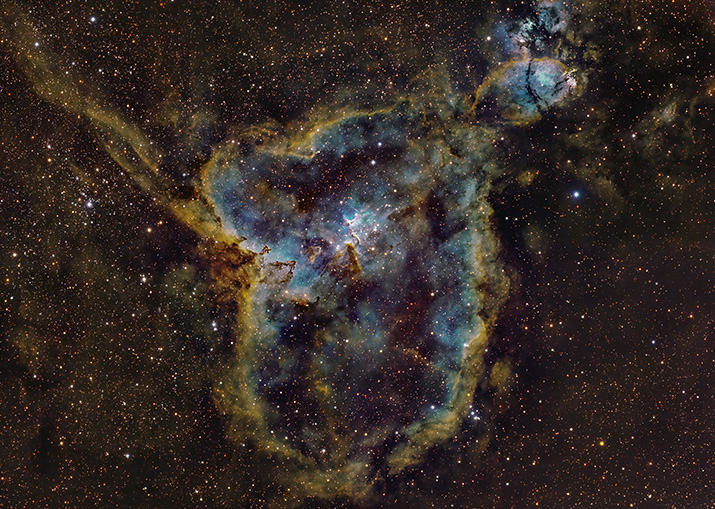
|
Object: IC1805 / Sh2-190 - The Heart Nebula (4 Panel Mosaic)
Date: Sept. 8-9-10-11, 2025 - Telescope: Officina Stellare f/3 RH200-AT - Camera: QSI-640
Click on the image below to view at higher resolution. |

|
IC 1805 (Sh2-190 in the Sharpless Catalog), known popularly as the Heart Nebula, is a glowing HII region in the constellation Cassiopeia. This celestial wonder, located approximately 2.0 kpc (6,500 light-years) distant[4], is comprised of vast clouds of gas and dust made luminous by ultraviolet radiation from young, massive, stars[2]. At its heart lies the open cluster Melotte 15 (also cataloged as Collinder 26), containing several stars nearly 50 solar masses in size[1]. The intense stellar winds and radiation from these giants sculpt the nebular gas into dramatic pillars, ridges, and dark lanes that frame the central cavity[2,3]. The stars in Melotte 15 are very young ranging between 1 and 3 million years old[4]. In the upper right of the image is IC 1795 (the "Fish-Head" Nebula), a neighboring star-forming region that blends into the Heart complex. In wide mosaics, such as the image above, the Fish-Head appears as a connected bright area and may be considered a part of the larger Heart Nebula complex[5]. The image above is known as a mapped, or false, color image and was acquired using narrowband filters. It was assembled using the standard Hubble palette with SII mapped to Red, Ha mapped to Green and OIII mapped to Blue. Stars were overlaid using broadband RGB data to preserve natural star color and detail. A near true color version of the Heart Nebula may be view here. This image was compiled from a 4-panel mosaic captured with an Officina Stellare (f/3) RH200-AT astrograph. The camera used was a QSI 640 with a Kodak KAF-8300 CCD.
Member of the Dark Sky Observatory Collaborative
References
|